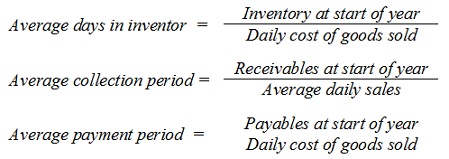Short-term financial planning is critical for a company to properly conduct its operating activity, meeting its short-term liabilities. The actuality of the thesis is that short-term planning and management are frequently where new hires start out in a corporation, especially in finance and accounting. Moreover, such planning is especially important for small businesses, and a lack of adequate short-term financial resources frequently results for small firms in a business failure. Thus, financial managers should know what they have to do with the excess money and how to deal with cash shortfalls.
Firstly, it is important to determine the difference among short-term, medium-term and long-term plans must be outlined. Short-term usually involves processes that show results within a year. Companies aim medium-term plans at results that take several years to achieve. Long-term plans include the overall goals of the company set four or five years in the future and usually are based on reaching the medium-term targets.
Furthermore, we must admit that there are some aspects that short term planning helps to solve. The manager should plan the amount of cash and inventory that company should have and the amount of credit company may extend to clients.
Thus, the managers consider such short-run operating activities as collecting raw materials, producing the products, gaining the income. That is why it is expedient to define the terms of operating cycle and cash cycle.
The operating cycle is the time between the arrival of inventory and the date when cash is collected from receivables. It is clear that cash is usually paid out before it is collected.
Meanwhile, the cash cycle starts when cash is paid out for materials and ends when cash is collected from accounts receivable. The longer the cash cycle, the more the need for financing.
If company buy inventory, sell its product, collect payment, and pay suppliers in one day, it means that the company have a cash cycle of zero days.
Additionally, the cash cycle may be simply represented by the following formula:
Cash cycle (days) = Average days in inventory +
+ Average collection period -
- Average payment period
where,

It must be outlined that common sources of short-term borrowing are operating loans, letter of credit and other sources. It's important to note that short-term interest rates are normally lower than long-term rates. This means that it's generally more expensive to use long-term borrowing than short-term borrowing.
Operating loans from banks are the most common way to finance temporary cash deficits. It is an agreement where the company can borrow up to a certain amount for a given period. Operating loans can be unsecured or secured by collateral.
Interest is charged on the loan and is set by the bank. Banks lend mainly to low-risk borrowers. This is why they often decline risky business loans. Many loan requests that banks turn down come from small businesses, particularly startups. These startups then often turn to alternative financing sources.
Financial institutions may require collateral for a loan, such as property, accounts receivable, or equipment. These are called secured loans. For secured loans, the interest rate charged is often less than with unsecured loans.
The other type is letters of credit and they allow borrowers to pay off a balance and borrow funds as needed. This differs from a short-term loan where the borrower receives a lump sum of cash and can borrow more only after the short-term loan is repaid.
In addition, companies use a variety of other sources of short-term funds such as short-term notes issued by highly rated firms, banker's acceptances that are similar to commercial paper except that they are guaranteed by a bank in exchange for a fee charged by the bank.
Furthermore, strategies for reducing cash flow problems must be noticed and they are as follows:
• Decrease cash cycle time. Help reduce the chances of cash flow problems;
• Cash reserves;
• Maturity hedging. It is usually better to avoid financing long-lived assets with short-term borrowing.
In conclusion, the nature of the firm’s short-term financial planning problem is determined by the amount of long-term capital it raises. A firm that issues large amounts of long-term debt or common stock, or that retains a large part of its earnings, may find it has permanent excess cash. In such cases there is never any problem paying bills, and short-term financial planning consists of managing the firm’s portfolio of marketable securities. A firm holding a reserve of cash is able to buy itself time to react to a short-term crisis. This may be important for growth firms that find it difficult to raise cash on short notice.
References
1. Principles of corporate finance (10th ed.) / Brealey R., Myers S. & Allen F. McGraw-Hill/Irwin: New-York, 2011, p. 969
_____________________
Науковий керівник: Жолнерчик Ганна Юріївна; кандидат економічних наук, доцент, Київський національний економічний університет імені Вадима Гетьмана
|








